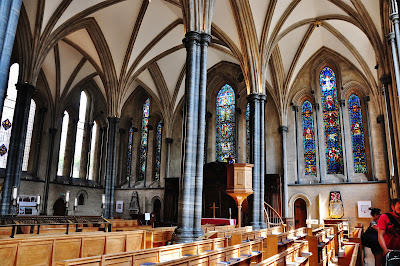(Replica of the Magna Carta)
Negotiations continued through the spring of 1215 with the Knight William Marshall (whose effigy lies in the floor of the Dome here) at the center of the discussion. In June of 1215, King John signed the Magna Carta to avoid a civil war.
(Another view of the Chancel)
The Magna Carta established that the King was not above the law, and that "free men" had rights under the law, such as:
(Sculpture within the Church)
"No free man shall be taken or imprisoned or dispossessed or outlawed or exiled or in any way ruined nor will we go or send aginst him except by the lawful judgement of his equals or by the law of the land." - Clause 39
(The Church suffered extensive damage due to bombing during WWII)
And, "To no one will we sell, to no one will we deny or delay right or justice." - Clause 40.
(The Dome was collapsed and burned)
Though King John signed the Magna Carta, it was nullified just 10 weeks later by Pope Innocent III, and England was plunged into war anyay. However, the Magna Carta was reissued several times after his death, and continued to be an important legal document.
(A WWII memorial in the floor of the Dome)
It was an inspiration to the American colonists who later included similar clauses into their Constitution and the Bill of Rights.
(The Royal Courts of Justice, across the street)
The Temple Church is the Church of the Inner and Middle Temple, two of Englands four ancient societies of lawyers. These two Inns of the Court managed and built around the Temple for years, and in 1608, King James I granted them a Charter giving them use of the Temple in perpetuity, with the condition that they must always maintain the Temple, which they have always done.








I want to thank you for all the wonderful information you write about the history of the places you visit...I have been a history buff all my life and truly appreciate how you explain things and have links for us to read more.
ReplyDeleteYou would make a great History teacher!
Alicia =0)